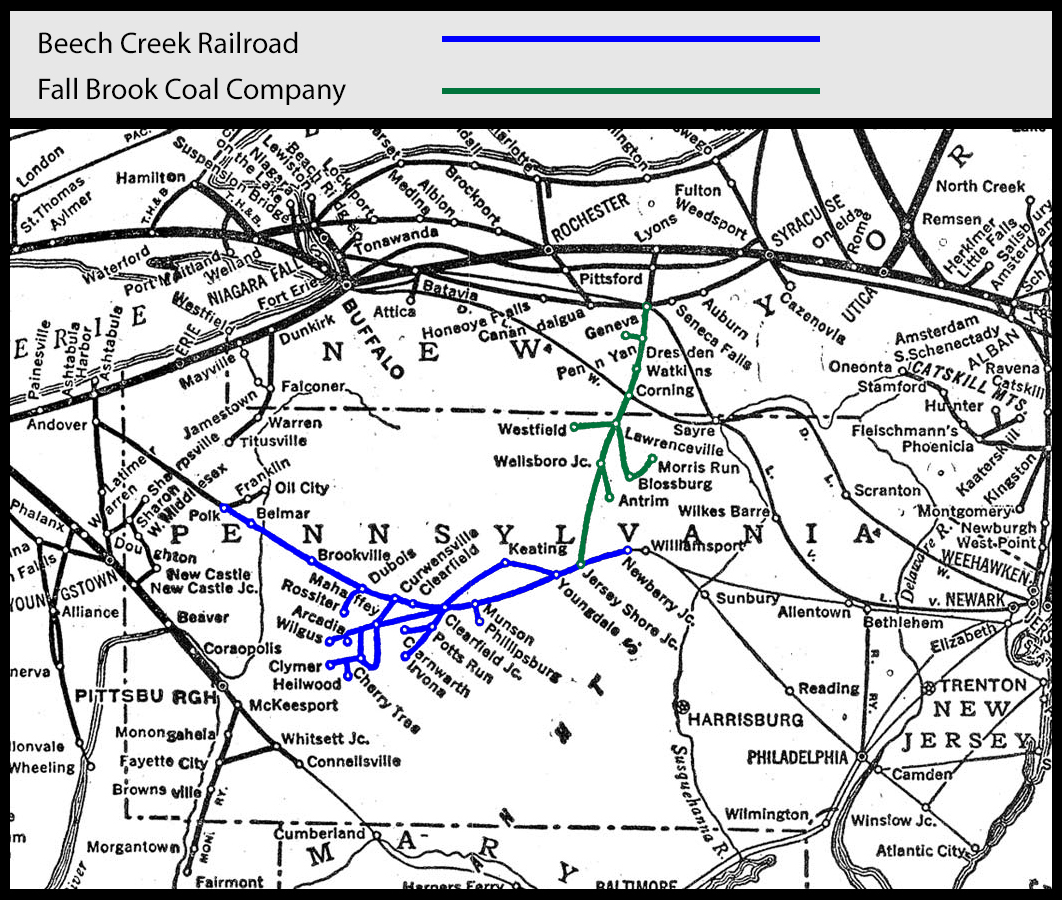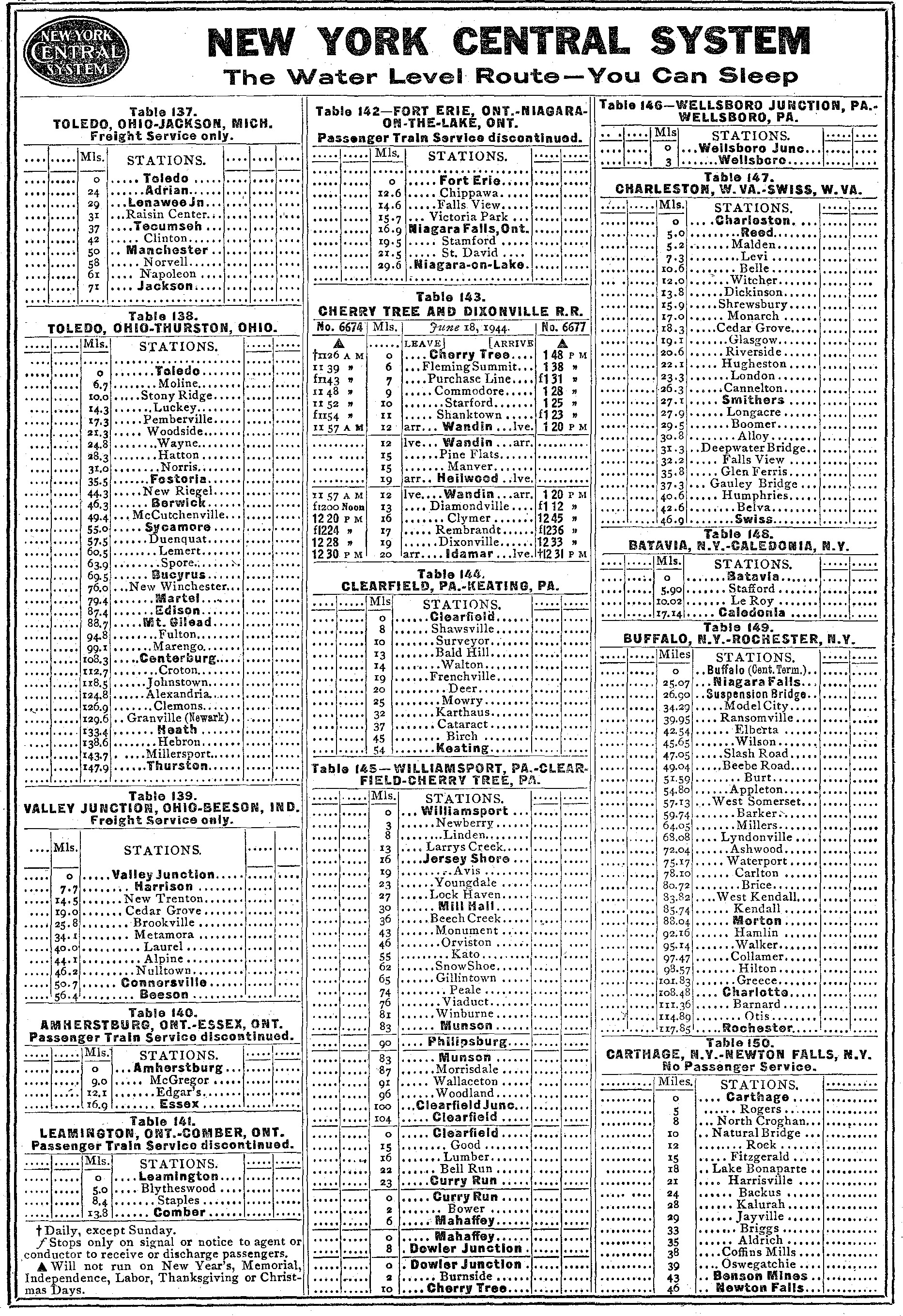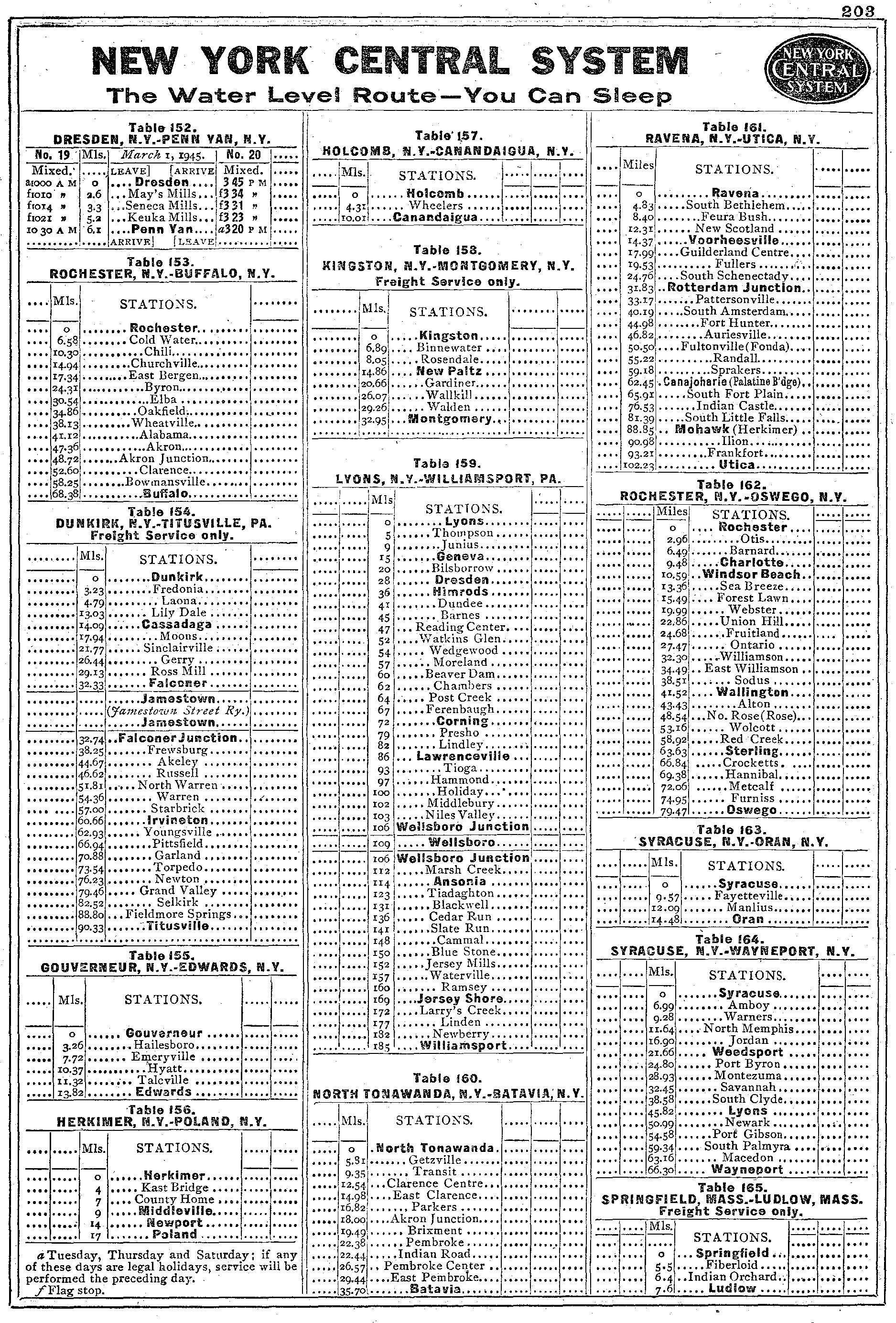Beech Creek Railroad: Map, History, Timetables
Published: February 19, 2025
By: Adam Burns
The Beech Creek Railroad and the Fall Brook Coal Company's lines were both longtime New York Central subsidiaries that provided the company its only substantial penetration into Pennsylvania, a state primarily dominated by the Pennsylvania and Erie.
Both properties were utilized as coal feeders for the NYC; the Fall Brook lines ran south from Central's main line at Geneva, New York to Jersey Shore Junction while the Beech Creek lines ran from roughly Williamsport to Polk.
After the mid-20th century the NYC's Pennsylvania Division saw decreasing use, especially in the Penn Central era. Conrail removed the remainder of the old Beech Creek in the early 1990s.
System Map (1940)
History
In the late 19th century, the New York Central strategically extended into territories traditionally dominated by the PRR and Erie in northern and central Pennsylvania.
This move was primarily aimed at safeguarding its access to locomotive fuel. During the late 1880s, coal mine proprietors increased coal prices by fifty cents per ton for shipments on the Central, provoking significant concern among NYC's management, especially William H. Vanderbilt.
Lacking substantial coal suppliers with direct investment in the company, the railroad found itself vulnerable to market forces, compelled to bear the cost increase. Consequently, the operational expenses for steam locomotives rose, with further hikes anticipated.
Timetables (1945)
In response, management sought reliable coal sources to stabilize costs and proximity to their core operations, as the PRR was already deeply entrenched in the coal regions.
Vanderbilt’s first strategic measure involved acquiring significant shares in the Philadelphia & Reading (Reading), a line that strategically traversed the Schuylkill coal fields in southeastern Pennsylvania and competed directly with the rival PRR.
By this stage, Vanderbilt's sons, Cornelius II and William K., had assumed control over the New York Central and invested in the McIntyre Coal Company, situated north of Williamsport, Pennsylvania.
They revitalized McIntyre with capital injections, including investments from affluent individuals like Samuel Clemens, better known by his pen name, Mark Twain. Clemens also collaborated with the Vanderbilts by purchasing shares in a newly reorganized venture, the Clearfield Bituminous Coal Company.
This venture aimed to utilize Clearfield coal in NYC's locomotives. Clearfield's affiliated Beech Creek Railroad extended west from Jersey Shore through the Clearfield coal region, ultimately connecting with a branch of the Lake Shore & Michigan Southern at Polk, Pennsylvania.
Construction
On August 12, 1882, the company initially received its charter as the Susquehanna & South Western Railroad. This charter outlined the development of a 100-mile rail line connecting Williamsport, Pennsylvania, with the southern boundary of Clearfield County.
Coal operators in Tioga County, many of whom already utilized the Fall Brook Coal Company's railroad to reach the NYC, were grappling with unrelenting labor disputes and the looming depletion of their coal mines.
The Vanderbilt family offered financial support to a coalition of Tioga coal operators and Clearfield-area entrepreneurs, which incorporated as the Clearfield Bituminous Coal Company, enabling them to acquire coal lands discreetly.
The Fall Brook's railroad network, extended down Pine Creek by the nominal Jersey Shore, Pine Creek & Buffalo Railway, intended to facilitate NYC trains reaching Jersey Shore on the West Branch Susquehanna River, west of Williamsport. From this point, the Susquehanna & South Western aimed to extend westward by way of Beech Creek and Moshannon Creek towards Clearfield.
The construction phase commenced at the close of 1882, initiating at the town of Beech Creek and moving westward along the creek to the Mountaintop area near Snow Shoe. The company subsequently was renamed as the Beech Creek, Clearfield, & South Western Railroad on March 20, 1883.
The Clearfield Bituminous Coal Company entered into an agreement to transport its coal exclusively via the new line, and George Magee was appointed as the primary contractor for the construction endeavors.
The railroad was constructed to exacting standards to accommodate substantial coal traffic. It avoided steep gradients, although this required significant curvature and numerous bridges as it traced Beech Creek.
The 347-foot-long Hogback Tunnel was built to traverse the creek, approximately halfway up the ascent from Hurxthal's Summit. Track laying commenced in September 1883. Concurrently, work began on the 1,277-foot-long Peale Tunnel, situated 8 miles west of the summit on the decline towards Moshannon Creek.
Tunneling began on June 24, 1883 and was largely completed by October 30th that same year. The line was fully operational by mid 1884, except for a nearby iron viaduct standing 112 feet high, which opened on November 11, 1884.
On June 29, 1886, the company encountered financial difficulties and was subsequently acquired by the newly established Beech Creek Railroad. Subsequently, the New York Central formally entered into a lease agreement with the company on December 15, 1890.
Fall Brook Coal Company
Additionally, the Fall Brook Coal Company, which by 1881 operated a line from NYC’s Auburn Road main line through Geneva, New York, into Pennsylvania, provided another strategic option. This line traversed the scenic "Grand Canyon of Pennsylvania" to Jersey Shore and continued a short distance eastward to Williamsport.
After NYC secured a long-term lease on the 153-mile Beech Creek Railroad, the Fall Brook lines were added in 1899. As a result, the railroad effectively eliminated its dependency on external coal suppliers, ensuring it was no longer susceptible to manipulations by coal-mine operators.
Decline and Abandonment
In 1968, the Central merged with long-time rival PRR to create the ill-fated Penn Central Transportation Company. This was the beginning of the end of its former coal lines in Pennsylvania. In 1966 cutbacks had already began when the central section from Snow Shoe-Mill Hall was removed, effectively cutting the line in half as a through route.
What remained conitnued under Conrail and remained operational until it, too, was abandoned in 1993. In 1994, Headwaters Charitable Trust acquired the right-of-way from Conrail, envisioning the conversion of the railway into a recreational trail. Today, a 19-mile stretch of the former line has been transformed into the "Snow Shoe Rails to Trails," serving as a versatile multi-use path that accommodates both motorized and non-motorized recreational activities.
Recent Articles
-
North Carolina's 'Wine Tasting' Train Rides
Dec 14, 25 07:31 PM
A noteworthy way to explore North Carolina's beauty is by hopping aboard the Great Smoky Mountains Railroad and sipping fine wine! -
Nevada's 'Wine Tasting' Train Rides
Dec 14, 25 07:20 PM
While it may not be the first place that comes to mind when you think of wine, you can sip this delight by train in Nevada at the Nevada Northern Railway. -
Nevada - Murder Mystery - Dinner Train Rides
Dec 14, 25 12:40 PM
Seamlessly blending the romance of train travel with the allure of a theatrical whodunit, these excursions promise suspense, delight, and an unforgettable journey through Nevada’s heart.






